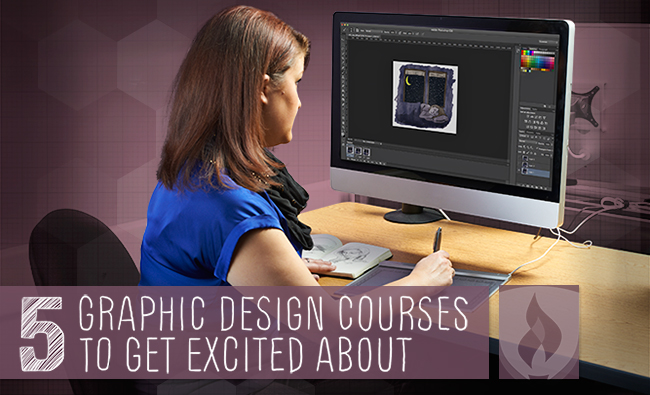
You’ve been described as innovative and creative your entire life, so it’s no surprise that you’re interested in pursuing a career in graphic design. You’ve heard about the benefits of earning a design degree but you want to know what you can expect from a graphic design degree program.
The flexible online degree options offered by the Rasmussen College School of Design are appealing to busy individuals like you. But before investing the time and money needed to earn a graphic design degree, you want to be confident the training and coursework is manageable and worthwhile.
We connected with Jennifer Ayotte, Rasmussen College School of Design dean, to help us identify five key courses included in the graphic design program. Her insight will give you a little taste of what you’ll experience after enrolling.
Keep reading for a sneak peek at these courses and how the curriculum at Rasmussen College stands out among other graphic design degree providers.
Graphic design courses to expect
Rasmussen College offers an Online+ graphic design program, which blends online courses with a traditional classroom feel. Software demonstrations and other interactive learning activities are easily incorporated into traditional curriculum.
Ayotte admits that the wealth of information included in the program could be intimidating to some, but her students have so much fun that they tend to forget they’re actually working. The following courses are what she believes to be the heart and soul of graphic design, preparing students to excel once they enter the field.
1. Design Foundations
This is the first software-based course in the curriculum. It’s strategically structured to ease students into the technical aspect of the industry, so you don’t need to be a computer whiz to take the course. The class incorporates a slew of helpful demo videos and also includes a weekly session with the instructor and other classmates.
The curriculum focuses heavily on the basics of graphic design, dispelling the myth that computers do most of the work. You’ll leave the course with a conceptual understanding of design principles. These fundamentals are necessary to create a solid foundation on which you can build your entire design career.
2. Intro to Animation
The content in this course is brought to life through lecture content, demo videos and custom illustrations and animations. You’ll be introduced to the 12 basic principles of animation and gain experience in sketching, storyboarding, animatics and other integral processes involved in animated film.
You’ll acquire hands-on training in researching, character and scene development and cameras and lighting. Learn about animation history while applying it to analog and digital projects.
3. Fundamentals of Web Design
This is an introductory course to the process of designing and developing websites. You’ll build a foundation in the planning, designing and production of web pages using cutting-edge, industry-standard software. Training in HTML, CSS and JavaScript will allow you to add some of the most in-demand design skills to your resume.
The loaded lecture pages included in the curriculum are chock full of visual examples and demo videos are also embedded throughout the course. Your weekly meetings with your classmates and instructor take the form of project critiques and Q and A sessions. This setup emulates the work environment of actual design teams, giving you a true taste of your future as a designer.
4. Character Modeling
This is sure to be a favorite for animation enthusiasts. The course is intended to help you hone your skills in 3D character creation and effects, breathing life into the characters you design. Curriculum is a blend of rich written content, helpful tutorial videos and custom illustrations to help you connect theory to action.
You’ll be exposed to advanced 3D modeling and animation theory that focuses on character animation as it applies to the gaming environment. Gain practical experience in morphing, blending and character posing and rigging for games. Completion of this course will prepare you for industry certification in Autodesk 3ds Max.
5. Portfolio Development
This is one of the most attractive courses in the entire program because a graphic designer’s portfolio is critical to success in the field. The class will allow you to develop an industry-quality portfolio under the supervision of seasoned professionals, as most of the Rasmussen Design instructors are experts currently working in the industry.
Built in to the course are four group sessions that will help you build up your portfolio pieces, practice your presentation pitch skills and showcase your final portfolio to a live panel comprised of peers and advisory board members. As one of the final graphic design courses in the program, you will walk away with a professional, polished portfolio to impress potential employers.
Do you like what you see?
You’re not investing the time and money towards a degree just to receive a piece of paper with your name on it. You’re more interested in acquiring the knowledge and training needed to succeed in your career. Your graphic design degree courses are the building blocks that will construct a solid foundation on which you’ll build your entire career.
So what do you think? Are you ready to join a state-of-the-art program that can help prime you for success in the graphic design industry? If so, click the red “Request Program Info” button on the top right corner of this page to learn how to enroll.




